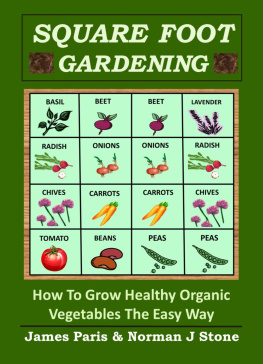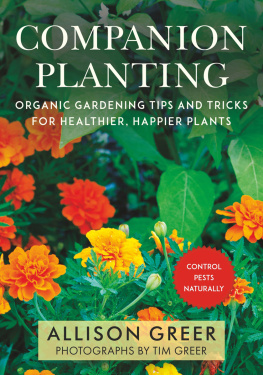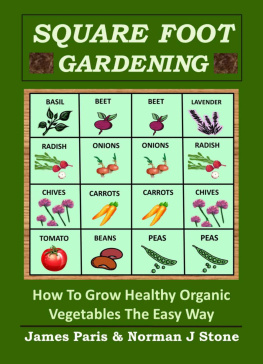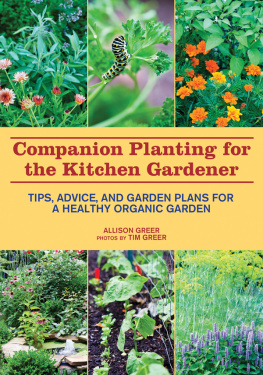Jennifer Scarffe - Companion Planting--The Lazy Gardeners Guide to Organic Vegetable Gardening
Here you can read online Jennifer Scarffe - Companion Planting--The Lazy Gardeners Guide to Organic Vegetable Gardening full text of the book (entire story) in english for free. Download pdf and epub, get meaning, cover and reviews about this ebook. year: 2019, publisher: Green Earth Books, genre: Home and family. Description of the work, (preface) as well as reviews are available. Best literature library LitArk.com created for fans of good reading and offers a wide selection of genres:
Romance novel
Science fiction
Adventure
Detective
Science
History
Home and family
Prose
Art
Politics
Computer
Non-fiction
Religion
Business
Children
Humor
Choose a favorite category and find really read worthwhile books. Enjoy immersion in the world of imagination, feel the emotions of the characters or learn something new for yourself, make an fascinating discovery.
- Book:Companion Planting--The Lazy Gardeners Guide to Organic Vegetable Gardening
- Author:
- Publisher:Green Earth Books
- Genre:
- Year:2019
- Rating:4 / 5
- Favourites:Add to favourites
- Your mark:
Companion Planting--The Lazy Gardeners Guide to Organic Vegetable Gardening: summary, description and annotation
We offer to read an annotation, description, summary or preface (depends on what the author of the book "Companion Planting--The Lazy Gardeners Guide to Organic Vegetable Gardening" wrote himself). If you haven't found the necessary information about the book — write in the comments, we will try to find it.
Is companion planting really a magic formula for abundant harvests and pest free crops? I believe it is, but there is so much more to the magic of organic vegetable gardening than simply knowing which plants enjoy each others company.
This companion planting guide is for gardeners who are prepared to go deeper than the simplistic carrots love tomatoes advice spruiked in other companion planting books. Instead youll learn how soil enrichment, compost, mulching and organic pest control methods all work together to create a diverse, complex natural system that yields far more than traditional gardening methods.
Written in an easily accessible and conversational style, this book delivers the nitty-gritty on all aspects of organic vegetable gardening and will soon have even the most novice of gardeners enjoying a bumper harvest. Best of all, the methods outlined in this book require a minimum of digging, hoeing and other such hard work. Instead youll be left with rich organic soils that do the bulk of the work for you, leaving you with lots of time to actually enjoy being in your garden.
Topics covered in this companion planting guide for beginners include:
Companion Planting and the relationship between organic soils, pests, weeds and fertility.
Pests and the uses of companion gardening to control pest numbers naturally. Interplanting, trap crops, repellent plants, attracting natural predators, organic bug sprays and human-made pest problems are all covered here.
Mulch and its absolutely vital role in companion gardening and organic soil.
Organic compost how to make it, how to use it, and how it will work wonders for your vegetable garden and flower garden, as well as reducing your household waste and lowering your carbon footprint.
Companion plant relationships - the basic and most important plant pairings, and crucially why they work and how to use them.
More than just a list of plant pairings copied from Wikipedia, this companion planting guide will give you a solid grounding in the basics of organic vegetable gardening, compost for beginners and soil nutrition, and will give you the tools to make your garden more productive and more enjoyable.
Jennifer Scarffe: author's other books
Who wrote Companion Planting--The Lazy Gardeners Guide to Organic Vegetable Gardening? Find out the surname, the name of the author of the book and a list of all author's works by series.

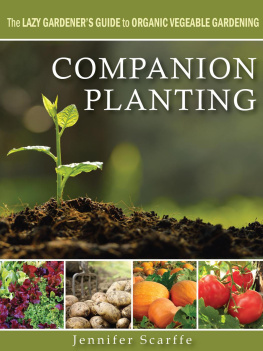
![Dowding - The Year-Round Vegetable Gardener’s Bible [7 Books in 1]](/uploads/posts/book/453239/thumbs/dowding-the-year-round-vegetable-gardener-s.jpg)
